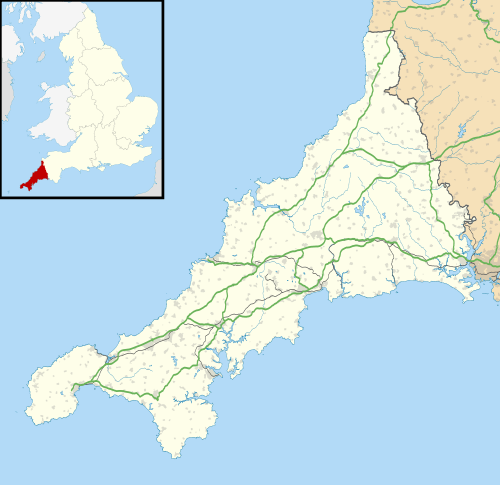Tideford
Tideford (/ˈtɪdɪfərd/;[1] Cornish: Resteudhi)[2] is a small village in east Cornwall, England, United Kingdom. It is twinned with Plouguerneau in Brittany, France.
Tideford
| |
|---|---|
 Tideford Location within Cornwall | |
| Population | 325 (2001 UK census) |
| OS grid reference | SX348597 |
| Civil parish | |
| Shire county | |
| Region | |
| Country | England |
| Sovereign state | United Kingdom |
| Post town | SALTASH |
| Postcode district | PL12 |
| Dialling code | 01752 |
| Police | Devon and Cornwall |
| Fire | Cornwall |
| Ambulance | South Western |
| UK Parliament | |
Its name derives from its location on the River Tiddy, literally meaning "Ford on the River Tiddy". Tideford is not listed in the Domesday Book but the earliest settlement is thought to have been around 1100AD. The bridge over the River Tiddy at the bottom of Bridge Road dates from the 14th century and this is the earliest surviving structure.
Tideford grew in the eighteenth century as the nearby Port Eliot country estate built a number of houses in the village. Many of these have now been sold, but of note is 'Bridge House', located at the bottom of Bridge Road, which remains a gatehouse onto the estate.
The village is on the busy A38 between Saltash and Liskeard, one of two main road routes into Cornwall (the other being the A30 which runs into north Cornwall). Tideford does not have a railway station, the nearest being at St Germans, some two miles south.
The village has a butchers' shop, a Post Office, a branch of the Royal British Legion, a Montessori nursery, an abattoir and a small public house.
Churches
The Victorian church of St Luke was designed by renowned architect George Wightwick. The building was originally erected as a chapel-of-ease in St Germans parish and was consecrated on 31 July 1845, consisting of a chancel, nave and gable-cote containing two bells. The church is fitted with oak seats and contains a pulpit. The registers date from 1845.
Tideford is now part of the united parishes of St Germans, Hessenford, Downderry and Tideford.
The small Wesleyan Methodist chapel was built in 1838 and there was also a Reformed Methodist chapel.
There was also once a Society of Friends' (Quakers') Meeting house and attached Burial Ground in Tideford.[3]
Twinning
See also
References
- G.M. Miller, BBC Pronouncing Dictionary of British Names (Oxford UP, 1971), p. 148.
- Place-names in the Standard Written Form (SWF) : List of place-names agreed by the MAGA Signage Panel. Cornish Language Partnership.
- David M Butler's Quaker Meeting Houses of Britain (1999) Volume 1 Page 72
External links
| Wikimedia Commons has media related to Tideford. |